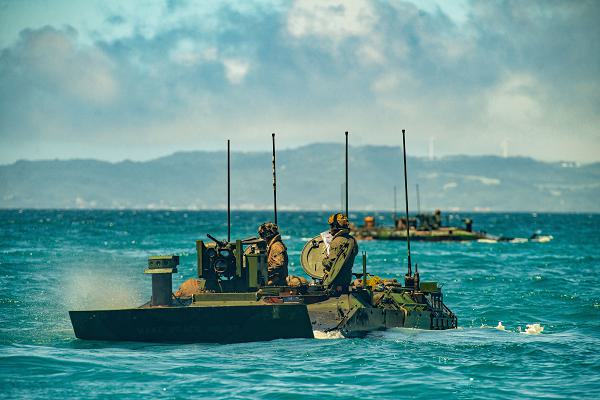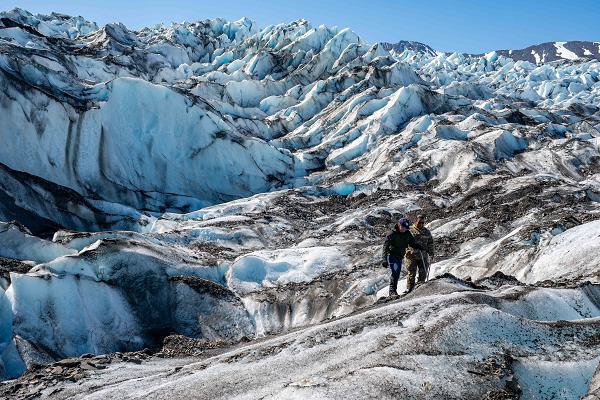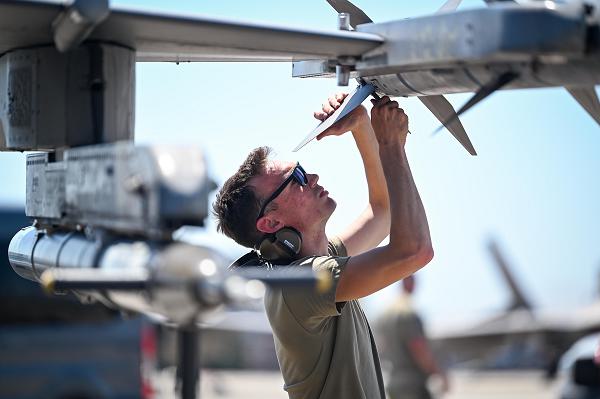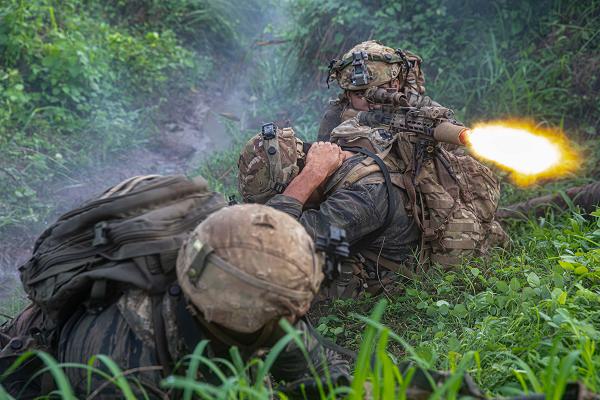- Details
- Hits: 1697

Okinawa, Japan. (June 25, 2024): The Marines have a brand-new vehicle to get from ship to shore and it does so much more. In this photo by Lance Corporal Peyton Kahle, the Marines’ latest Amphibious Combat Vehicles (AAV) attached to Alpha Company, Battalion Landing Team 1/5, 15th Marine Expeditionary Unit, conduct waterborne operations at White Beach Naval Facility here. Designed to replace the Corps aging AAVs that went into service in 1972, this updated version will be the primary means of tactical mobility and direct fire support for infantry battalions into the future.
The new transports come in four configurations: personnel carrier, command and control, recovery, and a 30mm gun variety.
The Personnel Variant (ACV-P) can carry three crewmembers and up to thirteen Marines with two days of combat equipment and supplies. It has the latest armor to protect against blasts, fragmentation, and kinetic energy threats.
The second configuration is designed for combat Command and Control (ACV-C)
that features multiple workstations and advanced digital communications capabilities. This variant provides a modernized, armor protected tactical command post for the regiment or battalion.
- Details
- Hits: 1373

Eglin Air Force Base, Florida. (July 5, 2024): It has been twenty-eight years since the shock and horror of the Khobar Towers bombing but the sense of loss remains. In this photo by Senior Airman Briana Beavers, Airman 1st Class Bobbie Mills places a rose to honor a fallen Airman during a memorial ceremony held here this week. According to Air Force tradition, placing a flower at the feet of the service member’s boots recognizes and honors their lost lives.
On June 25, 1996, Hezbollah terrorists detonated a truck bomb outside the gates to Khobar Towers, a residential housing complex used by the U.S. Air Force. Personnel belonging to the 4404th Wing, a rescue and fighter squadron, were participating in Operation Southern Watch that operated a no-fly zone operation in southern Iraq. The attackers were reported to have smuggled explosives into Saudi Arabia from Lebanon and then loaded them onto a sanitation truck. The explosion contained the equivalent of 30,000 pounds of TNT creating a blast so powerful it was felt twenty miles away in the Persian Gulf state of Bahrain.
In all, nineteen Airmen were killed, and another 498 personnel of many nationalities were wounded. In 2006, a U.S. court found Iran and Hezbollah guilty of orchestrating the attack and in 2020 ordered Iran to pay $879 million to the Khobar bombing survivors.
- Details
- Hits: 1152

Colony Glacier, Alaska. (June 4, 2024): It’s a guarantee to every servicemember; America will never quit looking for you if you are missing… ever. In this photo by Technical Sergeant Don Hudson, Captain Travis Lockwood, Operation Colony Glacier deputy ground forces commander, and Lieutenant Colonel Crystal A. Glaster, Air Force Mortuary Affairs Operations deputy commander, trek across the site of a 1952 crash of a C-124 Globemaster II aircraft that took the lives of all fifty-two people on board. Captain Lockwood leads Operation Colony Glacier, an annual summer expedition seeking the remains of the crash victims. Colonel Glaster coordinates Air Force search efforts while collaborating with the Joint POW/MIA Accounting Command that is charged with recovery of missing servicemembers. Teams of military and civilian personnel defy the elements to uphold our nation's pledge to leave no service member behind.
On a stormy night on November 22, 1952, a Douglas C-124 Globemaster II military transport aircraft issued a distress call which was received by a nearby commercial pilot. The Globemaster was flying without visual references and was using altitude readings, a radio beacon, and a stopwatch for navigation. There was no further communication from the C-124, and it failed to arrive at Elmendorf Air Force Base near Anchorage. The plane had a crew of 11 and 41 Army and Air Force passengers.
- Details
- Hits: 1119

Tyndall Air Force Base, Florida. (June 28, 2024): In this photo by Senior Airman Steven Cardo, Senior Airman Brett Egan, 79th Fighter Generation Squadron weapons load crew member, checks training munitions before takeoff during exercise Checkered Flag 24-2. Checkered Flag is a live fire exercise that is part of the Air Force’s Weapons System Evaluation Program. This event is the Department of Defense’s largest air-to-air live fire evaluation and is used to assess the performance of pilots and air crews under simulated combat conditions.
The maneuvers were led by the 79th Fighter Squadron "Tigers", a combat ready F-16C/D squadron tasked with air-to-air, air-to-surface, and suppression of enemy air defense missions. Organized in 1918, the 79th is one of the oldest squadrons in the Air Force that saw action in both world wars and was part of the United States Air Forces in Europe (USAFE) during the Cold War.
This year’s maneuvers involved sixty aircraft from the 79th Squadron flying over 230 hours in 111 sorties to evaluate its enemy air suppression abilities on a large-scale. The evaluation allowed ground crews and pilots to conduct air-to-air missile and 20 mm gun live-fire training while rehearsing tactics they would use in real combat.
- Details
- Hits: 978

Washington, D.C. (June 18, 2024): Summer is here and that means the Navy Band and its talented artists will be on display during a series of performances at our nation’s Capital. In this photo by Petty Officer 1st Class Ava Conway, Petty Officer 1st Class Ashleigh Leas and Petty Officer 1st Class Madeline Jarzembak perform as part of the Navy Band’s flute and harp duo during the band’s chamber recital series.
The Navy’s premier Concert/Ceremonial Band is staffed by 85 musicians who rotate between concert and ceremonial duties. The band is recognized as one of the finest wind ensembles in the world and has dazzled audiences for over a century. The concert band unit performs marches, patriotic selections, and modern wind ensembles on national tours and public conferences throughout the year. They also perform at official government functions and special events including those held at the White House. The Navy Band also has the honor of conducting ceremonies for funerals at Arlington National Cemetery.
- Details
- Hits: 1505

Fort Magsaysay, Philippines. (June 17, 2024): In the event of war, how do you set up a command center in the middle of dense jungle halfway around the world? In this photo by Staff Sgt. Thomas Moeger, Sergeant Ratu Komaisavai fires his weapon during a simulated engagement in the jungles of the Philippines during Joint Pacific Multinational Readiness Center-Exportable (JPMRC-X). The concept is to create a “deployable” package of personnel and equipment that can be dispatched to establish Joint Operating Centers (JOC) to run military exercises anywhere in the world.
The JOC facilitates real-time information sharing, joint planning, and direct coordination among participating units. For this deployment, Army CH-47 Chinook helicopters ferried everything from food and water to huge communication towers into the jungle sixty miles north of Manila. Working alongside the Philippine Army’s 7th Infantry Division, members of the American 25th Infantry Division cut new roads and trails through dense vegetation to allow rapid movement of supplies and equipment to support the exercises.


